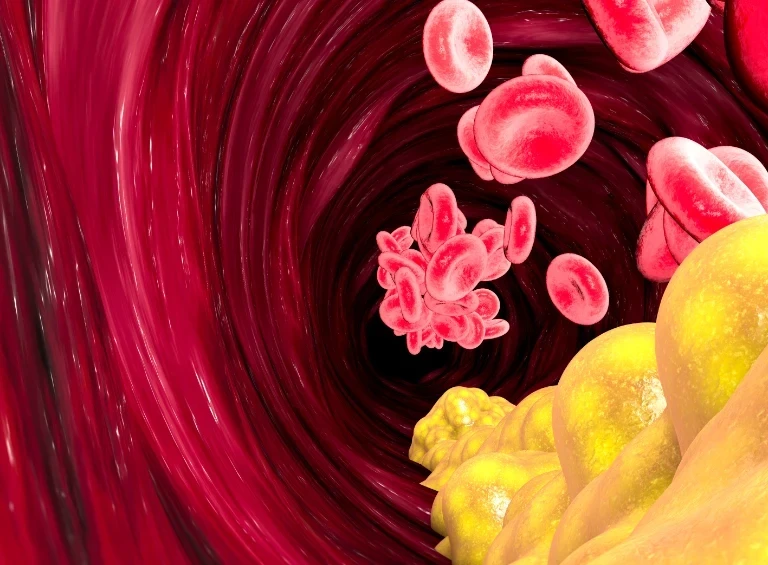Hypercholesterolemia Treatment Patterns and Lipid Target in ACS Patients: HYDRA-ACS Registry

The multicenter HYDRA-ACS registry provided insights into current treatment situation of hyperlipidemia after acute coronary syndrome (ACS) among patients in Germany. The study findings showed that despite receiving lipid-lowering therapy (LLT), only half of very high-risk patients achieved recommended lipid targets (<70 mg/dL) within 12 months post ACS
Key Takeaway
- The HYDRA-ACS registry investigating the clinical characteristics and current treatment of very high-risk patients with ACS and hyperlipidemia in Germany showed:
- Two-thirds of the patients received LLT at the time of index event, while all the patients received therapy at 12 months post event
- Statins were the most commonly prescribed LLT (85.0%), followed by cholesterol resorption inhibitors (32.9%)
- Proprotein convertase subtilisin/kexin type 9 inhibitors (PCSK9i) were prescribed to only 0.7% of patients
- Only half (50%) of the patients achieved recommended target level of <70 mg/dL (2016 ESC/EAS dyslipidemia guideline), despite significant decrease in low-density lipoprotein cholesterol (LDL-C) level at 12-month follow-up
- Moderate increase in high-density lipoprotein cholesterol (HDL-C) (45 to 47 mg/dL) and decrease in triglycerides (148 to 119 mg/dL) were observed after 12 months
- Two-thirds of the patients received LLT at the time of index event, while all the patients received therapy at 12 months post event
- The study highlighted that an increased adoption of modern treatment approaches, such as PCSK9i, could improve the lipid target achievement in very high-risk patients in the future.
Why This Matters
- Patients with ACS are at high risk of subsequent cardiovascular (CV) events; therefore, long-term treatment of CV risk factors, such as hyperlipidemia, hypertension, or diabetes mellitus, is critical in preventing further progression.
- However, many patients do not achieve recommended target levels of LDL-C, despite receiving LLT.
- Therefore, HYDRA-ACS registry was initiated to provide insights into the current treatment situation for very high-risk patients with ACS and hyperlipidemia in Germany.
Study Design
- HYDRA-ACS study (national, prospective, multicenter, non-interventional registry) was conducted across 24 centers in Germany.
- Inclusion criteria: Adult ACS patients (≥18 years) with (i) LDL-C >155 mg/dL and first-degree relative with premature myocardial infarction (MI)/premature MI; (ii) LDL-C >190 mg/dL without premature MI/without premature MI in first-degree relative
- Study objectives (baseline to 12-month follow-up): (i) lipid target achievement as measured by LDL-C reduction over time and absolute and relative reductions in LDL-C; (ii) absolute and relative change in total cholesterol, HDL-C, and triglycerides; (iii) use of non-drug LLT (lifestyle and nutrition) and percentage of patients using non-drug LLT over time, as well as use of LLT and percentage of patients receiving LLT over time; (iv) drug utilization patterns for secondary prevention and percentage of patients receiving such pharmacotherapy over time; and (v) CV and cerebrovascular events over time, including percentage of patients with complications at baseline, and percentage of patients with non-fatal events since baseline
Key Results
- A total of 391 ACS patients were enrolled: After exclusion of 38 patients, baseline analysis set (BAS)* comprised of 353 patients and 140 patients were included in the full analysis set (FAS)*.
Key baseline characteristics in BAS and FAS group:
| BAS (n= 353) | FAS (n = 140) | ||
| Age, years (mean ± SD) | 57.3 ± 11.4 | 59.6 ± 11.3 | |
| Males, % | 73.4 | 66.4 | |
| BMI, kg/m2 (mean ± SD) | 32.9 | 25.7 | |
| Cardiovascular history,% | Coronary heart disease | 32.9 | 25.7 |
| Percutaneous intervention | 25.5 | 20.7 | |
| Acute coronary syndrome | 23.0 | 19.3 | |
| Comorbidities, % | Arterial hypertension | 68.6 | 70.7 |
| Diabetes | 17.3 | 12.1 | |
| Heart failure | 16.7 | 19.3 | |
BAS, Baseline analysis set; BMI, Body mass index; FAS, Full analysis set; SD, Standard deviation
Cross-sectional analysis (BAS):
- Most common LLT: Statins (40.0%), cholesterol resorption inhibitors (9.4%)
- Lifestyle and nutrition: 46.2% of patients had no physical exercise, while only 15.0% exercised >3 times/week. 73.9% consumed fruits and vegetables at least 3 times/week, while 69.7% ate fish (<2 times/week). 47.9% of patients consumed alcohol (<2 drinks/day) and 45.6% were smokers
- Frequently used CV pharmacotherapies: Antihypertensives (angiotensin-converting enzyme inhibitors [ACEi; 32.9%] and beta-blockers [23.8%]), platelet aggregation inhibitors (37.7%), and antidiabetic agents (10.5%)
- Lipid profile levels:
- Median LDL-C: 166 mg/dL; most patients (65.2%) had a level of >150 mg/dL, with only 5.1% having a level of <70 mg/dL
- Median total cholesterol: 235 mg/dL, of which 31.6% had a level >260 mg/dL
- Median HDL-C: 43 mg/dL; majority of patients (65.2%) had a level of <45 mg/dL (men) or <55 mg/dL (women)
- Median triglycerides: 162 mg/dL; 45.8% had a level of >172 mg/dL
Longitudinal analysis (FAS):
- Use of LLT (12 months vs baseline):
- Proportion of patients receiving statins (85.0% vs. 36.5%, P = 0.0002) and cholesterol resorption inhibitors (32.9% vs. 8.6%, P = 0.0003) notably increased
- Statin use peaked post-index event, but slightly declined by 12 months, while the use of cholesterol resorption inhibitor steadily increased from baseline after index event to 12-month follow-up
- Only 0.7% of patients were prescribed PCSK9i at 12 months after ACS o Use of combination therapy increased
- Lifestyle and nutrition: Proportion of patients engaging in no physical exercise decreased from 40.0% (baseline) to 24.0% at 12 months (P <0.0001); consumption of fruit and vegetables (P = 0.0222) and fish (P = 0.0162) increased, while alcohol decreased (P = 0.0019)
- CV pharmacotherapies: Increase in the proportion of patients (12 months vs baseline) receiving antihypertensives (mostly beta-blockers [64.3% vs 23.6%], diuretics [58.6% vs 17.9%], angiotensin II receptor blockers [30.0% vs 16.4%], and ACEi [42.1% vs 29.3%], P2Y12 antagonists (35.7% vs 9.3%), and other platelet aggregation inhibitors (77.9% vs 26.4%)
- Lipid profile levels:
- Median LDL-C: Significantly decreased at 12-month follow-up visit vs baseline, with increase in proportion of patients having levels <70 or <55 mg/dL.
- A moderate increase in median HDL-C and decrease in median triglyceride level were seen post 12 months
| BAS (n = 353) | FAS (n = 140) | P value | ||
| Baseline (cross-sectional analysis) | Baseline (Longitudinal analysis) | 12 months | (12 months vs baseline) | |
| LDL-C, mg/dL, median (IQR) | 166 (128, 198) | 166 (129, 196) | 87 (70, 106) | <0.0001 |
| >150 mg/dL, % | 65.2 | 63.6 | 7.1 | <0.0001 |
| >100 mg/dL, % | 86.9 | 87.1 | 27.9 | <0.0001 |
| <70 mg/dL, % (2016 ESC/EAS dyslipidemia guideline) | 5.1 | 5.7 | 50.0 | <0.0001 |
| <55 mg/dL, % (2019 ESC/EAS guideline) | 0.9 | 1.4 | 6.4 | 0.0310 |
| Total cholesterol, mg/dL, median (IQR) | 235 (194, 271) | 228 (200, 265) | 152 (135, 173) | <0.0001 |
| >260 mg/dL, % | 31.6 | 26.9 | 0.8 | <0.0001 |
| HDL-C, mg/dL, median (IQR) | 43 (36, 51) | 45 (39, 55) | 47 (39, 56) | 0.0235 |
| m <45 / f <55, mg/dL, % | 62.5 | 58.3 | 53.7 | 0.1172 |
| Triglycerides, mg/dL, median (IQR) | 162 (111, 234) | 148 (103, 196) | 119 (90, 179) | 0.0080 |
| >172 mg/dL, % | 45.8 | 38.4 | 28.0 | 0.0196 |
BAS, baseline analysis set; FAS, full analysis set; HDL, high-density lipoprotein; IQR, interquartile range; LDL, low-density lipoprotein
Outcomes assessed in FAS during 12-month follow-up:
- Percutaneous coronary intervention (PCI; 25.9%), cardiac catheterization without PCI (12.9%), and MI (2.4%)
- Stroke and transient ischemic attack (0.0%)
- Overall, 38.8% of patients required hospitalization due to an event and 68.2% of patients received rehabilitation therapy
- No deaths were reported
Key Limitations
- Severe loss to follow-up of patients during the study period
- Differences in patient characteristics between those with and without follow-up, such as higher proportions of male patients, those with diabetes, and coronary heart disease might have impacted the outcomes data, requiring cautious interpretation of rates.
*BAS included eligible patients with documented entries in the first eCRF section (used for cross-sectional data analysis). FAS comprised all BAS patients with LDL-C and LLT documentation at index event and 12-month follow-up (used for longitudinal data analysis); Note: Conversion factor – to get from mg/dL to mmol/L for total cholesterol, HDL, and LDL: multiply by 0.02586 and for triglycerides: multiply by 0.01129
Please refer source publication Gitt AK, et al for additional details.
Gitt AK, Parhofer KG, Laufs U, März W, Paar WD, Bramlage P, et al. Hypercholesterolemia diagnosis, treatment patterns and target achievement in patients with acute coronary syndromes in Germany. Clin Res Cardiol. 2023;112(2):299–311. doi: 10.1007/s00392-022-02108-w. PMID: 36114838.



